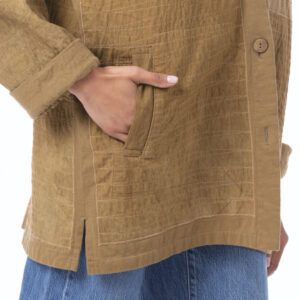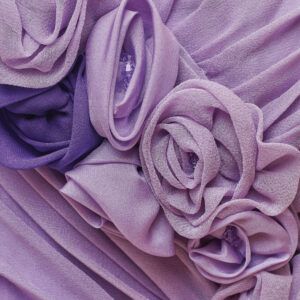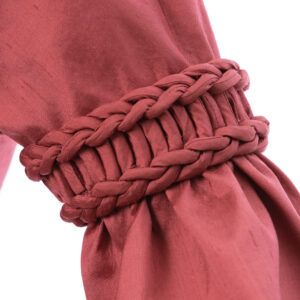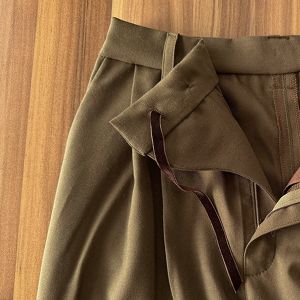Is it possible to pintuck cotton/lycra/spandex on an ordinary sewign machine without the fabric being stretched. If so, how
Conversational Threads
Threads Insider
Get instant access to hundreds of videos, tutorials, projects, and more.
Start Your Free TrialAlready an Insider? Log in
Conversational Threads
Highlights
-
Sign up for the Threads eletter
This site is protected by reCAPTCHA and the Google Privacy Policy and Terms of Service apply.See all newsletters -
 Sponsored Content
Sponsored Content
Where to Buy
-

-

-

-























Replies
Maybe with a stretch needle? What might actually work is a really narrrow stitch on a serger with the differential feed engaged. I'm trying to imagine how and why you would use this!
Maybe with a Sticky or presson stabilizer under the fabric to prevent it stretching and doing corded pintucks to provide support and keep the shape intact.
With a serger, you can bypass the cutting blade, fold the fabric wrong sides together, do a narrow rolled hem that looks like a pintuck on wovens or knits.
Interesting idea, let us know what works for you! Mary
I like the idea of using a stablilizer underneath. I have a feeling this would make the material too thick to achieve a thin pintuck. In fact, you have given me the idea to use organza underneath, but I can't think of anything to stick the two together.
I don't have a serger; can anyone justify the expense on the serger.
Sulky makes a very good temporary spray adhesive that only lasts a few minutes.
We have many posts here about sergers, don't get me started....I use my serger more than my other machines for seams, seam finishing, and artistic work. You can do a search here under sergers if you are interested. Mary
Can I justify the expense of a serger? YES!! Mine was worth every penny! It's one of those things you think you can do without until you have one, and then you can't imagine how you managed before. Even at a basic level, the satisfaction of flat-finished seam allowances is huge, and being able to sew and finish stretch seams all in one go is a treat.
Well, in that case and working on a budget, how does this grab you; I would like critical comments from you (~$380)
Janome 9102D overlocker
Lightweight and compact.
3 or 4 thread overlocking.
Differential feed system to cope with stretchy fabrics.
Easy colour coded threading system.
Adjustable stitch width.
Uses standard ball point needles.
Powerful motor.
Includes instructional DVD and comes pre-threaded.
Includes 5 x needles, standard foot, 2 x screwdrivers and tweezers.
Size (H)30, (W)27, (D)23cm.
Weight 7kg.
2 year manufacturers guarantee.
http://www.sewforum.com and http://www.patternreview.com have many sewing machine and serger reviews that may be helpful to you.
I would get a book from the library on sergers or to some dealers and learn all sergers can do. You may want to do coverstitch, chainstitch, rolled edges,and flatlock, as well as overlocking. I like using 2 thread rolled hems, some machines don't allow this. I rarely use the 5 thread capability.
Test drive, some machines vibrate too much. I hated my first serger and only used it to finish seams, traded it in on a Husqvarna/Viking Huskylock 936 many years ago. It paid for itself the first year. I love it!
Serger Secrets is a great book. There are many serger workbooks that may help you decide what will fit your needs and budget. http://www.lindaleeoriginals.com is a good serger website. Also http://www.nancysnotions.com (from PBS Sewing With Nancy) has lots of great products and info.
Hope this is helpful. Mary
Well, I have done the deed and ordered the Serger Secrets book. The few reviews there are and the critical positive about diff. feed I may well go for this said serger (they call it overlocker here in the UK). If I can do most things on my old Brother sewing machine, I should damn well get about the same from the Janome 9102D
Thank you for you time and opinions
I can't add much to what's been said. I most often work with three threads on mine, which is a 4 thread Brother Lock 925D and must be about 10 years old - no bother with it at all but it's probably basic by comparison with some. If I had to replace it I would be interested in roll hemming and 2 thread uses. It's so often true that one doesn't use a lot of the bells and whistles on the more complex machines. Check that parts/extras can be ordered easily.
"Check that parts/extras can be ordered easily."
Good thinking!
I am not familiar with the Janome serger, or thier products, sorry. I own three Husqvarna/Viking machines, a Singer, and had a beautiful Necchi at one time.
I had a very basic inexpensive serger for awhile, hated it, it required changing many parts to do different techniques, the tensions were a royal pain, it didn't do a coverstitch or chainstitch. It didn't make pretty fine rolled hems as you see on napkins and heirloom work. I quickly traded it in for a machine that fit my needs. Before I traded it in, I did months of research, wrote everything about each serger brand and model in a spiral notebook. I read about them online at the company websites to learn about what stitches existed. I test drove many brands.
I have arthritis in my hands so I thought I would love the jet air threading on one brand. Just as I was about to buy it, I decided to test drive it one more time. I brought along some specialty threads that I like to work with. It wouldn't take the 12 or 30 weight threads into the air threader even when using a thread cradle technique. I often use heavier threads and yarns and Wooly nylon in my loopers. I am so glad that I test drove that machine one last time before my purchase! I ended up going with what I thought was my second choice brand serger. I love it and use it for alot of artistic work and embellishing, even quilting now.
I cannot express enough, the importance of finding the best machine for your personal needs by research and test driving. Some dealers will allow you to trade up for another machine if done within a certain timeframe. The other day, I met a lady who was buying the lowest level serger that she can afford. She already plans on trading up in 6 months to a year and was offered full price trade up in the future.
I think it is great that you are asking alot of questions before you make that leap. Whether it is a few dollars, a few hundred, or a thousand, we don't want to waste it, right? Mary
The differential feed is an important feature! It does fast easy gathering and ruffling, as well as helpful with knits and other fabrics. Most sergers today have this.
Have you got a generic checklist of what parts require replacing often
I have never had to replace any parts on my serger, I think it is nine years old. Others may have more info on this. Maybe http://www.sewforum.com or one of the serger sights on yahoo.
The cutting blades may get dull and need to be replaced by an authorized dealer. Some people do this themselves, I wouldn't risk it myself as if it's not done right, it will ruin a machine.
The main thing about sergers is to brush out all the lint each time you use it. When you use the cutting blade, which trims off a tiny bit of fabric which creates the lint. This will cause problems if left to build up. NEVER use canned air to blow out the machines! This can cause them to freeze up. (I bought a little set of vacuum attatchments for $10.00 that works great for sewing machines and computers and such. I use it about once a month too, or if I've worked with fleece or velvet.) Mary
cutting blades may get dull and need to be replaced by an authorized dealer. .... it will ruin a machine
Interesting you write this. Can you expand on how the machine will be ruined if using either dull knives or sharpening at home. I ask because I do all my knives, serrated knives and bread knife and anything else on the Arkansas stone.
If the cutter knives are dull, the fabric won't move smoothly through the machine. We also sharpen our knives at home, however, I have heard horror stories from people who have reinserted the blades improperly or not tightly enough, or too tightly and then had expensive repairs needed on thier sergers. I have an expensive serger, so would rather just take it into the shop to have them take on the respnsiblilty as they guarantee thier work. It's just my personal choice/opinion.
to all;
I have a Pfaff serger, it's 18 years old, and don't know how I used to manage without it. Recently I shortened a knitted hat with the serger. It worked great. Couldn't have done as good a job with a regular sewing-machine.
For brushing lint out of a machine's innards.... I have a small artist's brush with stiff bristles- see photo- which I use to get the fluff and bits out. It has picked up some machine-oil, and this helps the lint stick to the bristles. I poke it far into the back corners and retrieve dustbunnies that thought they were hidden. I flick the collection off into a trashcan, and it's ready to use again.
I just realized, this lint-brush is over 40 years old, and still in use!
PS- the machine pictured is about to get a thorough cleaning, and not just with the brush, either!
Edited 11/17/2007 1:48 pm by Tangent
Edited 11/17/2007 7:50 pm by Tangent
That's a great tip! I will have to go through my paint brushes and pick one out to use for cleaning the serger! I love the photo! It shows that with a bit more effort, the sewing machine companies could do a much better job with thier manuals. I remember trying to find good photos of thread paths on the serger! Mary
Computers and digital cameras have made making your own manual or diagrams a possibility. Take a photo of the parts you need to see, and print it. With colored markers you can draw the thread paths on the printout.
Use dabs of colored nail-polish or enamel model-paint (matching your colors on the picture) to highlight beside the thread eyes in the machine. Use a Q-tip to wipe the spot first with nail-polish remover to remove any traces of oil, or the paint might not stick.
I am back with two problems:
1. How does one feed fabric other than on its edge, for example, when sewing darts. I can't because the upper looper snags the fabric.
2. I wanted to get a pintuck on the stretch fabric, but because of problem 1, I can't.
Apart from that, at present at least, I have no problems.
I don't see how the loopers would snag the fabric? It may be the wrong needle for your fabric that is snaging it, or the feed dogs. If it is the feed dogs, you may need to put tissue paper or water soluble stabilizer under the fabric or wrapped around the fabric edge with this fabric.
I don't make darts on the serger. I like the more crisp effect done on a sewing machine.
You may want to get more experience with your new serger before tackling this project. Are you using a narrow rolled hem, or which stitch? This technique with your knit fabric sounds like a more advanced technique, so please don't be offended.
Here is how I would set my machine for a 3 thread rolled hem on light knit fabric for pintucks: Stitch length 1.0, Differential 0.9, stitch width (cutting blade width) 6.0, Right Ballpoint needle 6, Upper looper 3, lower looper 6.
Do you have a blind hem foot? This would work well to adjust for the width of pintuck you desire and to keep the fabric free of the blade.
I draw the lines on the right side of my fabric with chalk pencil. You fold the fabric, wrong sides togeather, wrap the edge with water soluble stabilizer and finger crease for a sharper edge, place the fold to the left of the cutting blade so the fabric is not cut. It may take some fiddling to get the settings just right. (A serged pintuck will be rounder and softer looking than one done with the sewing machine and a twin needle.)
I hope this helps. Mary
make darts on the serger: I was experimenting and quite pleased with narrow takeup of the cloth, it didn't have bumps on the right side
serged pintuck will be rounder and softer looking than one done with the sewing machine and a twin needle. Ahh! But disappointing on the knit fabric. Mind you I was trying this on chocolate brown fabric and the white thread supplied with the machine.
Do you have a blind hem foot? No, at this stage do you think it is necessary expense?
I would set my machine for a 3 thread rolled hem on light knit fabric for pintucks:
I did
Stitch length 1.0, Differential 0.9, stitch width (cutting blade width) 6.0, Right Ballpoint needle 6, Upper looper 3, lower looper 6
I will try with these settings
I don't use a special foot, I just thought that if you have it already, it might help you avoid the cutting blade and keep your line straight.
Good luck with those pintucks! Just keep fiddling with the settings until you get a nice balanced stitch. Some fabrics just need more TLC like princesses! Mary
I forgot to tell you congratulations on getting your new serger! So, congratulations!!! I hope you will love it! Which one did you buy? Mary
Thank you. I wrote earlier that because of budget restraints I bought Janome 9102D. So far it is behaving quietly and performing the jobs I want.
cool beans! Happy serging! The settings on your machine may have a different range, so the "numbers" I offered may be off. My tension settings are 0-9, so the 6 is the "Normal" or "middle" setting. Hope this clarifies if necessary.
My head is going beyond my manual capacity; I have a question
Can you use two needles and the lower looper thread to create something like a coverstitch (my serger doesn't have cover stitch nor does it tell me how to work with two threads).
The closest thing to a coverstitch hem would be to overlock the fabric edge, then straight stitch on the sewing machine with the double needles.
I recently purchased a Janome 3434D basic serger for $189 US (on sale). I was looking to buy the 9102D and as I looked at the two of them side by side they are nearly the same.......the tension disks and the DVD were the two difference and the price difference was $90 (both models were on sale at the time)..........couldn't justify the extra expense. The 3434D is working just fine. I have larger and more complicated sergers as well........this new one is a replacement for a smaller one that I gave away and then wished I hadn't!! I did note that I couldn't find the 3434D on the Janome website as it is made just for Hancock fabrics. If you aren't in the US (something tells me you are not), this model may not work for you but the 9102D would surely be a good machine for you. I have had several Janomes past and present and they are good machines for the money. This new one does the normal serger stitches as well as the rolled hem without changing needle plate, etc. The 9102D is the same in that respect.
I, too, bought my first serger wondering if I was throwing money away. Boy! That was a joke.........I, too, now use my sergers more than my sewing machines when I constructing garments or home dec. things. I don't do the fancy stitches with the serger that many do but just for speed of construction and durability of a garment.....the serger can't be beat!
There you have my nickels worth!
Kay
the 9102D would surely be a good machine for you Crazy K
And I have done; it gets here tomorrow - can't wait
water soluble stabilizer adhered to the fashion fabric with a temporary spray Zuwena
This was suggested yesterday, but your use of soluble stabilizer makes work quite easy
tissue paper Crafygirl
Even lighter
I like all these ideas very much. Thank you, thank you, and thank you
Edited 11/14/2007 2:57 am ET by rekha
I'm happy with my 3434D.......which is nearly the same. I also have an Elna 704Dex; a Janome Compulock and a Babylock Evolve. The little Janome sits at the ready with black thread and is a great 'extra' back up machine. I love the little guy. Also it's a bit smaller and lighter if I want to move a machine to a different location.
You'll love your serger. Have a ball.......and learn all you can about them. You'll wonder how you managed!!
Happy Sewing!
May
I just did a cute crazy patch Christmas stocking using the 3 thread wide overlock, with either 12 wt. Sulky or varigated silver metallic/cream wooly nylon in the upper looper. I used Maxilock cone serger thread for the needle and lower looper.
Stitch length 1.5-2, left needle normal, lower looper normal, upper looper tension around 1.5-2 for a balanced stitch. You put the fabric pieces wrong sides together, make sure you go clockwise when adding the next fabric. Always have the right side of the fabric facing you.
Alot of the artistic stuff I do on the serger has more to do with the tension adjustments and the thread choices than the model of serger. It's amazing how much can be done with the basic stitches! Mary
At present none of this makes any sense to me. When I get the serger tomorrow and the book in a few days, I shall begin to understand how important all this is
An early present! How wonderful! Take your time and be patient with yourself from the get go. It will all come together soon. I hope you will love serging! Mary
I would suggest using a water soluble stabilizer adhered to the fashion fabric with a temporary spray. After you have completed the pintucks cut away the extra and after you have completed the garment, give it a wash to wash away the stabilizer and you will not have altered the feel or drap of the fashion fabric.
If you can just insert the pin tucks into the garment at a specific place then you can create a continuous strip of pintucks on a straight piece of fabric following the straight grain or cross grain, whichever has the least stretch. In this latter case you may not need the stabilizer but it should work just as well either way.
hope this helps. Zuwena
I make costumes and sometimes the fabrics I use must be drycleaned, or should not be washed before delivering to my customer. Try adjusting the pressure on your presser foot, if you have that capability. Also, a truly low tech, low cost way: tissue paper. Place a small strip, the length of the pintuck, under the fabric and stitch. The tissue paper will tear away pretty easily. Also, in a bind I have used low tack masking tape, stick it to the fabric where you want to stitch. You can use scissors to cut it as thin as you need it to be in one long strip. As long as you use it on the right side when you sew, it doesn't add bulk and removes very easily, with out residue, and without having to wash the garment immediately to remove.
Do you want the pintuck to stretch along with the rest of the fabric?
You might want to try using wooly nylon in you bobbin of your regular machine. It's a serger thread with lots of stretch. Maybe use a small width double needle set on a very small zigzag with wooly nylon in the bobbin.
stitchagain
You make a valuable point, thank you
This post is archived.